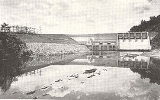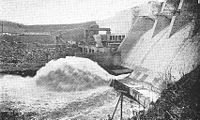
Boone Dam
Encyclopedia
Boone Dam is a hydroelectric and flood control dam on the South Fork Holston River on the border between Sullivan County and Washington County in the U.S. state of Tennessee
. It is one of three dams on the South Fork Holston owned and operated by the Tennessee Valley Authority
, which built the dam in the early 1950s as part of greater efforts to control flooding in the Tennessee River
watershed. The dam impounds the 4500 acres (1,821.1 ha) Boone Lake
, and its tailwaters are part of Fort Patrick Henry Lake.
Boone Dam is named for frontiersman Daniel Boone
(1734-1820), who was active in the general area in the 1760s.
proper). The Watauga River
joins the South Fork Holston almost immediately upstream from the dam, creating a V-shaped reservoir that extends for 17 miles (27.4 km) up the South Fork Holston (all the way to Bluff City
) and for 15 miles (24.1 km) up the Watauga. The Sullivan-Washington county line follows the reservoir for most of its Watauga span. Boone Dam is 31 miles (49.9 km) downstream from South Holston Dam
and 10 miles (16.1 km) upstream from Fort Patrick Henry Dam
.
(completed in 1912) on the river's Watauga River tributary, no major dam projects were attempted. In the 1920s, the Holston River Power Company surveyed the river basin with plans to build four dams, and identified the present Boone site (the company called it the "Bachman Ford" site). In the 1930s, when the Tennessee Valley Authority assumed oversight of flood control operations in the Tennessee River
watershed, the agency suggested the Boone site (the agency originally called it the "Spurgeon Island" site) as a potential dam site. As Watauga Dam
and South Holston Dam (further upstream) neared completion in the late 1940s, the Spurgeon Island site was the next logical step in development of the South Fork Holston. The project's primary purpose was to provide flood control in the region, especially for Kingsport
(a few miles downstream), which had suffered major flood damage in 1901 and 1940. The dam would also add hydroelectricity to TVA's energy grid, which by 1950 had been maxed out by increasing demands from consumers and from Atomic Energy Commission
facilities at Oak Ridge
. Work on Boone Dam began August 29, 1950.
 The construction of Boone Dam and its reservoir required the purchase of 5160 acres (2,088.2 ha) of land, 1363 acres (551.6 ha) of which had to be cleared. 152 families, 104 graves, and 18 miles (29 km) of roads had to be relocated, and three new bridges were built. The outbreak of the Korean War
The construction of Boone Dam and its reservoir required the purchase of 5160 acres (2,088.2 ha) of land, 1363 acres (551.6 ha) of which had to be cleared. 152 families, 104 graves, and 18 miles (29 km) of roads had to be relocated, and three new bridges were built. The outbreak of the Korean War
brought increased support from federal entities, and work progressed without interruption.
Boone Dam was completed and its gates closed December 16, 1952. The dam's first generator went online March 16, 1953, its second generator went online June 12, 1953, and the third went online September 3, 1953. The total cost of the Boone project was $27.7 million.
Tennessee
Tennessee is a U.S. state located in the Southeastern United States. It has a population of 6,346,105, making it the nation's 17th-largest state by population, and covers , making it the 36th-largest by total land area...
. It is one of three dams on the South Fork Holston owned and operated by the Tennessee Valley Authority
Tennessee Valley Authority
The Tennessee Valley Authority is a federally owned corporation in the United States created by congressional charter in May 1933 to provide navigation, flood control, electricity generation, fertilizer manufacturing, and economic development in the Tennessee Valley, a region particularly affected...
, which built the dam in the early 1950s as part of greater efforts to control flooding in the Tennessee River
Tennessee River
The Tennessee River is the largest tributary of the Ohio River. It is approximately 652 miles long and is located in the southeastern United States in the Tennessee Valley. The river was once popularly known as the Cherokee River, among other names...
watershed. The dam impounds the 4500 acres (1,821.1 ha) Boone Lake
Boone Lake
Boone Lake is a reservoir in Sullivan and Washington counties in northeastern Tennessee, formed by the impoundment of the South Fork Holston River behind Boone Dam....
, and its tailwaters are part of Fort Patrick Henry Lake.
Boone Dam is named for frontiersman Daniel Boone
Daniel Boone
Daniel Boone was an American pioneer, explorer, and frontiersman whose frontier exploits mad']'e him one of the first folk heroes of the United States. Boone is most famous for his exploration and settlement of what is now the Commonwealth of Kentucky, which was then beyond the western borders of...
(1734-1820), who was active in the general area in the 1760s.
Location
Boone Dam is located 19 miles (30.6 km) above the South Fork Holston River's confluence with the North Fork Holston River (which forms the Holston RiverHolston River
The Holston River is a major river system of southwestern Virginia and east Tennessee. The three major forks of the Holston rise in southwestern Virginia and have their confluence near Kingsport, Tennessee. The North Fork flows southwest from Sharon Springs in Bland County, Virginia...
proper). The Watauga River
Watauga River
The Watauga River is a large stream of western North Carolina and East Tennessee. It is 60 miles long with its headwaters on the slopes of Grandfather Mountain and Peak Mountain in Watauga County, North Carolina.-Hydrography:...
joins the South Fork Holston almost immediately upstream from the dam, creating a V-shaped reservoir that extends for 17 miles (27.4 km) up the South Fork Holston (all the way to Bluff City
Bluff City, Tennessee
Bluff City is a city in Sullivan County, Tennessee, United States. The population was 1,733 at the 2010 census. It is part of the Kingsport–Bristol –Bristol Metropolitan Statistical Area, which is a component of the Johnson City–Kingsport–Bristol, TN-VA Combined Statistical...
) and for 15 miles (24.1 km) up the Watauga. The Sullivan-Washington county line follows the reservoir for most of its Watauga span. Boone Dam is 31 miles (49.9 km) downstream from South Holston Dam
South Holston Dam
South Holston Dam is a hydroelectric and flood control dam on the South Fork Holston River in Sullivan County, in the U.S. state of Tennessee. It is the uppermost of three dams on the South Fork Holston owned and operated by the Tennessee Valley Authority, which built the dam in the 1940s as part...
and 10 miles (16.1 km) upstream from Fort Patrick Henry Dam
Fort Patrick Henry Dam
Fort Patrick Henry Dam is a hydroelectric dam on the South Fork Holston River within the city of Kingsport, in Sullivan County in the U.S. state of Tennessee...
.
Capacity
Boone Dam is a concrete gravity-type dam 160 feet (48.8 m) high and 1532 feet (467 m) long, and has a generating capacity of 81,000 kilowatts. While the main section of the dam is a concrete structure, the northern half of the dam consists of a 750 feet (228.6 m) earth-and-fill structure that seals off the floodplain adjacent to the main river channel. The dam's overfall spillway has five radial gates with a combined maximum discharge of 137000 cuft/s. Boone Lake has 168 miles (270.4 km) of shoreline and a flood storage capacity of 75829 acre.ft. The reservoir's operating levels vary by about 20 feet (6.1 m) in a typical year.Background and construction
Both public and private entities were aware of the hydroelectric potential of the South Fork Holston River in the early 1900s, although other than Wilbur DamWilbur Dam
Wilbur Dam is a hydroelectric dam on the Watauga River in Carter County, in the U.S. state of Tennessee. It is one of two dams on the river owned and operated by the Tennessee Valley Authority. The dam impounds Wilbur Lake, which extends for about up the Watauga to the base of Watauga Dam...
(completed in 1912) on the river's Watauga River tributary, no major dam projects were attempted. In the 1920s, the Holston River Power Company surveyed the river basin with plans to build four dams, and identified the present Boone site (the company called it the "Bachman Ford" site). In the 1930s, when the Tennessee Valley Authority assumed oversight of flood control operations in the Tennessee River
Tennessee River
The Tennessee River is the largest tributary of the Ohio River. It is approximately 652 miles long and is located in the southeastern United States in the Tennessee Valley. The river was once popularly known as the Cherokee River, among other names...
watershed, the agency suggested the Boone site (the agency originally called it the "Spurgeon Island" site) as a potential dam site. As Watauga Dam
Watauga Dam
Watauga Dam is a hydroelectric and flood control dam on the Watauga River in Carter County, in the U.S. state of Tennessee. It is owned and operated by the Tennessee Valley Authority, which built the dam in the 1940s as part of efforts to control flooding in the Tennessee River watershed...
and South Holston Dam (further upstream) neared completion in the late 1940s, the Spurgeon Island site was the next logical step in development of the South Fork Holston. The project's primary purpose was to provide flood control in the region, especially for Kingsport
Kingsport, Tennessee
Kingsport is a city located mainly in Sullivan County with some western portions in Hawkins County in the US state of Tennessee. The majority of the city lies in Sullivan County...
(a few miles downstream), which had suffered major flood damage in 1901 and 1940. The dam would also add hydroelectricity to TVA's energy grid, which by 1950 had been maxed out by increasing demands from consumers and from Atomic Energy Commission
United States Atomic Energy Commission
The United States Atomic Energy Commission was an agency of the United States government established after World War II by Congress to foster and control the peace time development of atomic science and technology. President Harry S...
facilities at Oak Ridge
Oak Ridge, Tennessee
Oak Ridge is a city in Anderson and Roane counties in the eastern part of the U.S. state of Tennessee, about west of Knoxville. Oak Ridge's population was 27,387 at the 2000 census...
. Work on Boone Dam began August 29, 1950.

Korean War
The Korean War was a conventional war between South Korea, supported by the United Nations, and North Korea, supported by the People's Republic of China , with military material aid from the Soviet Union...
brought increased support from federal entities, and work progressed without interruption.
Boone Dam was completed and its gates closed December 16, 1952. The dam's first generator went online March 16, 1953, its second generator went online June 12, 1953, and the third went online September 3, 1953. The total cost of the Boone project was $27.7 million.
External links
- Boone Reservoir — official TVA site

